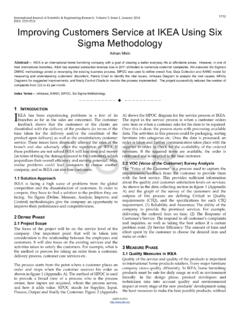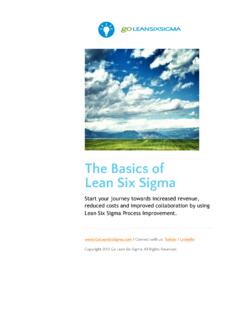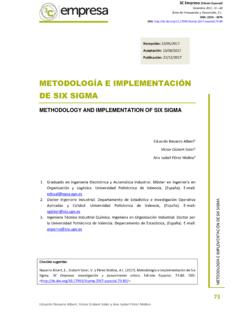Transcription of A Case Study of Defects Reduction in a Rubber Gloves ...
1 Proceedings of the 2012 International Conference on Industrial Engineering and Operations Management Istanbul, Turkey, July 3 6, 2012 472 A Case Study of Defects Reduction in a Rubber Gloves Manufacturing Process by Applying Six sigma Principles and DMAIC Problem Solving methodology Ploytip Jirasukprasert Warwick Manufacturing Group The University of Warwick, Coventry, CV4 7AL, UK Jose Arturo Garza-Reyes School of Technology The University of Derby, Derby, DE22 3AW, UK Horacio Soriano-Meier Northampton Business School The University of Northampton, Northampton, NN2 7AL, UK Luis Rocha-Lona National Polytechnic Institute of Mexico Business School, Mexico City, 03100, Mexico Abstract The Six sigma s problem solving methodology DMAIC has been one of several techniques used to improve quality.
2 This paper demonstrates the empirical application of Six sigma and DMAIC to reduce product Defects within a Rubber Gloves manufacturing organisation. The paper follows the DMAIC methodology to investigate Defects , root causes and provide a solution to reduce/eliminate these Defects . The analysis from employing Six sigma and DMAIC indicated that the oven s temperature and conveyor s speed influenced the amount of defective Gloves produced. In particular, the design of experiments (DOE) and two-way analysis of variance (ANOVA) techniques were combined to statistically determine the correlation of the oven s temperature and conveyor s speed with Defects as well as to define their optimum values needed to reduce/eliminate the Defects .
3 As a result, a Reduction of about 50% in the leaking Gloves defect was achieved, which helped the organisation studied to reduce its Defects per million opportunities (DPMO) from 195,095 to 83,750 and thus improve its sigma level from to Keywords Defects Reduction , DMAIC, Rubber Gloves , Six sigma 1. Introduction In today s world, business has become more and more competitive. All industries and organisations have to perform well in order to survive and be profitable. As well as the Rubber Gloves manufacturing industry, the organisation studied in this paper itself has to maintain the quality of its products so as to be able to delight customers and thus effectively compete in the market.
4 In general, one of the most vital concerns for the Rubber Gloves manufacturing industry is the Reduction of common quality Defects such as holes and stain in Gloves . From this point, not only does an organisation waste its resources and time to re-manufacture the products, but it also contributes to the loss of customers satisfaction and trust. As a result, this has driven a particular Thai Gloves manufacturing organisation to improve the quality of its products in order to create a competitive strategic advantage for its business and introduce itself to become a global organisation for further prospects. This paper investigates quality issues at a Thai Rubber Gloves manufacturing company and provides a solution to reduce/eliminate the most common Defects .
5 In order to 473 accomplish this, the paper evocates the principles and tools of one of the most effective quality management and improvement methodologies, Six sigma . In particular, the DMAIC (Define-Measure-Analyse-Improve-Control) problem-solving and improvement model of Six sigma is followed. Under the umbrella of this model, several statistical and quality improvement tools such as fishbone diagram, Pareto chart, Design of Experiments (DOE) and two-way analysis of variance (ANOVA) have been used. As an initial step, the paper briefly reviews some of the relevant theory of Six sigma and DMAIC, paying particular attention to the benefits and the positive impact on performance that these approaches bring to organisations, and the manufacturing process studied.
6 2. Literature Review on Six sigma Six sigma was proposed by Motorola, in the mid-1980s, as an approach to improve production, productivity and quality, as well as reducing operational costs [1]. The sigma s name originates from the Greek alphabet and in quality control terms, sigma ( ) has been traditionally used to measure the variation in a process or its output [2]. In the Six sigma s terminology, the sigma level is denoted as a company s performance [3]. Particularly, a Six sigma level refers to Defects per million opportunities (DPMO) [4], or in other words, to have a process which only produces Defects per every one million products produced.
7 Besides being a measure of variability and organisation s quality performance, Brue and Howes [5] mention that Six sigma is also a management philosophy and strategy as well as a problem-solving and improvement methodology that can be applied to every type of process to eliminate the root cause of Defects . In particular, some authors argue that the main benefits that an organisation can gain from applying Six sigma are: cost Reduction , cycle time improvements, Defects elimination, an increase in customer satisfaction and a significant raise in profits [3, 4, 6, 7]. Markarian [8] suggests that not only can the process improvement generated by Six sigma be used in manufacturing operations, as it is the case for the project presented in this paper, but it can also be expanded to improve business sectors such as logistics, purchasing, legal and human resources.
8 In addition, Kumar et al. [9] state that although Six sigma is normally used in Defects Reduction (industrial applications), it can also be applied in business processes and to develop new business models. Banuelas et al. [10] claim that other benefits such as (1) an increase in process knowledge, (2) participation of employees in Six sigma projects and (3) problem solving by using the concept of statistical thinking can also be gained from the application of Six sigma . To illustrate this point, during the utilisation of Six sigma in this research project, several tools and techniques were employed. Therefore, skills in the use of these tools were built up within the staff of the Thai organisation studied.
9 As a consequence, people involved in the project enhanced their knowledge and skills. As a reason, not only does an organisation itself gain benefits from implementing Six sigma in terms of cost savings, productivity enhancement and process improvement, but individuals involved also increase their statistical knowledge and problem-solving skills by conducting a Six sigma project. One of the Six sigma s distinctive approaches to process and quality improvement is DMAIC [11]. The DMAIC model refers to five interconnected stages ( define, measure, analyse, improve and control) that systematically help organisations to solve problems and improve their processes.
10 Dale et al. [6] briefly defines the DMAIC phases as follows: Define this stage within the DMAIC process involves defining the team s role; project scope and boundary; customer requirements and expectations and the goals of selected projects [12]. Measure this stage includes selecting the measurement factors to be improved [2] and providing a structure to evaluate current performance as well as assessing, comparing and monitoring subsequent improvements and their capability [4]. Analyse this stage centres in determining the root cause of problems ( Defects ) [2], understanding why Defects have taken place as well as comparing and prioritising opportunities for advance betterment [13].







